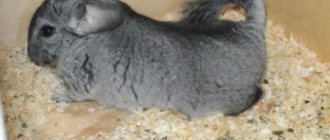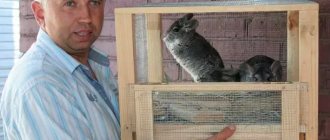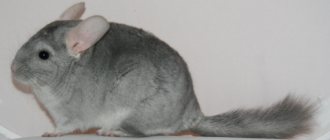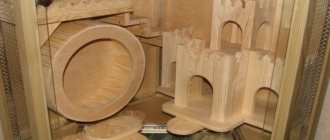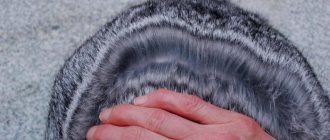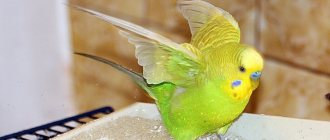Every owner of a chinchilla as a pet should know about the need to periodically bathe the animal. sand for chinchillas is collected in a bath or other container .
sand for chinchillas
Using any liquid for this process may harm your pet's health. This is due to the high density of the fur, which is why it dries slowly. The result is the creation of a favorable environment for pests and even decay, which can lead to the death of the pet.
Sand baths
For everyday care of the animals' thick and dense fur, sand is enough. It is sand baths that chinchillas take in nature every day. And that's why:
- Sand removes dead skin particles well,
- Frees fur from fallen hairs,
- Cleans from parasites
- Does not cause fur to get wet,
- Does not lead to hypothermia.
When kept at home, a bathing suit with sand is placed in the cage for an hour and a half, at least three times a week.
In large display cages, you can install a permanent bathing suit, but you need to ensure that the fur and skin of the animal do not dry out, and also remove all feces in a timely manner.
Why is it needed?
It is considered normal for people and animals to bathe in water, but such unusual animals as chinchillas have taken a more difficult path and prefer to take bathing procedures in volcanic sand in nature. The sand bath becomes a complete replacement for the standard water bath. To keep the fur of these rodents looking clean and well-groomed even at home, you need to bathe them in sand.
One square centimeter of a chinchilla's coat contains about 300 tufts of 80 hairs each, which is why this animal is considered the leader in fur density. Moisture and fat form in the hairs, and skin secretions accumulate in the tufts. Grains of sand, falling on the wool, absorb all the moisture. In addition, when taking a sand bath, chinchillas feel very comfortable; they perceive the procedure as a game.
Classic bathing in water is not suitable for this animal, since dense wool will take a long time to dry out and can provoke putrefactive processes, which can have a detrimental effect on the health of the animal.
In this regard, each owner must take safety measures while walking the pet around the apartment : close all rooms where there may be water (bathroom, toilet), put away buckets and basins with water.
Sand for swimming
Sand for bathing chinchillas has little in common with ordinary quartz. Special sand for chinchillas is made from zeolite and sepiolite. Zeolites are frame silicates and have a pronounced pearlescent luster. The main advantage of zeolite is the absorption or release of moisture depending on the level of humidity and temperature in the room. Most often, zeolite sand is used on large chinchilla farms. The remaining mixtures also contain large fractions of ordinary sand to reduce the dustiness of the zeolite. Sepiolite is a fibrous and porous material belonging to the talc group. It is very close in its composition and structure to marine pumice.
You can add medical sulfur powder or the drug Fungistop to the purchased mixture.
This is a good prevention of fungal diseases. It is especially recommended to do this after visiting a veterinarian or an exhibition.
Talc and other additives
To ensure that your pet feels great after bathing and does not contract any fungal diseases, talc or other similar substances should be added to the bathing sand. It will not only protect the chinchilla from parasites, but also prevent the appearance of unpleasant odors. In specialized stores you can find ready-made formulations with all the necessary additives that are necessary for the health of your pet. You can purchase such a set and not rack your brains over this dilemma anymore.
Veterinarians also advise choosing those that contain sulfur and talc. After all, they are the ones who most effectively fight various bacteria and fungal diseases.
The choice of mixtures is truly huge
Ready-made bath mixtures
The cost of the finished mixture in the store varies from 95 to 1500 rubles. A bucket of Vaka Chistyulya mixture, with a capacity of 1.6 liters, costs about 110 rubles. The composition contains soapstone, which is of natural volcanic origin. The German Vitacraft mixture consists of sepiolite, but some brands of the same sand are obtained by processing ordinary river sand to a very fine fraction. Another manufacturer of swimsuit filler, Little One, uses soft volcanic sand in its mixtures. But it costs more, starting from 600 rubles. The Chistyulya Lux mixture also consists of volcanic sand. It absorbs moisture well and cleans the fur without distorting the color of the animal. If your chinchilla is bathed every day, it is better to use the most natural mixture possible. Inexpensive and good option for the Zverushka mixture. It consists of talcomagnesite, an excellent sorbent that does not dry out the skin or damage the fur.
One of the best, but most expensive bathing sands is produced under the Padovan Bathingsand brand. Compound:
- 60% sepiolite,
- 30% volcanic sand,
- 10% soapmagnesite.
Sand quality
Even purchased sand needs a quality check before it goes into a chinchilla’s bath. One of the easiest ways to check is to pour a tablespoon of the prepared mixture into a bowl, add a few drops of water and leave for about an hour. A good and high-quality mixture forms lumps that are easy to remove. If, when removed, the lump begins to crumble, it means that it contains a high content of quartz and it is better not to use such sand.
The quality of the mixture can be determined in another way. It requires a small glass in which a tablespoon of sand is placed. After this, water is poured into the glass (about half the volume). The glass with sand and water is left for two to three hours. After the set time, the water is carefully drained. If there is a lot of clay in the mixture, sediment will remain at the bottom. If you transfer this sediment to a sheet of paper and hold it up to the light, you can see inclusions of bright and shiny particles. This is quartz. The more quartz, the worse.
By rubbing the mixture in your palms, you can also check the quality of the sand. A good and high-quality mixture does not scratch or irritate the skin, does not cause discomfort and does not leave a matte shine. However, in this way it is not always possible to determine the exact content of quartz; it may be too fine.
Why doesn't a chinchilla want to bathe? How to train?
Sometimes chinchillas categorically do not want to swim: they do not go into the bathing tub, or they behave very anxiously in it: they try to get out and even go to the sand to go to the toilet. All this indicates the animal’s discomfort, the causes of which must be identified and eliminated. This behavior of an animal can be influenced by several factors:
- low-quality or too coarse sand, causing unpleasant sensations;
- deterioration of health associated with illness;
- small age.
Chinchillas want to bathe
When teaching a chinchilla to bathe, you should act very gently, in no case using force:
- First of all, it is worth replacing the sand with products from another manufacturer. If you have just purchased an animal, you should ask the breeder for a little sand, which he is used to, and add a little to the bathing suit.
- There is no need to closely monitor the animal: it is better to prepare a bath and leave. It is quite possible that the chinchilla will become more active and begin hygiene procedures.
- If a small animal has never bathed before, if possible, you need to demonstrate the process to it using the example of adults. You can sprinkle a little sand on it.
- If no methods help, you should take the animal to the veterinarian to rule out possible health problems.
Making homemade sand
Despite the fact that sand for chinchillas can be purchased at any pet supply store, some owners prefer to make it themselves. For a homemade mixture, it is better to use quartz or river sand with the finest fraction you can find. If possible, use volcanic sand or coral sand. Coral sand is fine, delicate, has the necessary fluidity and is not so dusty.
Before making a mixture for bathing chinchillas with your own hands, any of the selected types of sand must be rinsed well and calcined in the oven. A few teaspoons of crushed talc and the same amount of medical sulfur are added to the already cooled sand.
Quartz sand is not suitable, it hurts the skin of animals
If the chinchilla population is large, then it is quite understandable why you should make a bath mixture yourself: this is a good money saver.
However, if there are only a few pets, it is more advisable to buy ready-made sand for chinchillas at a pet store.
Bathing chinchillas in the sand: features of choosing sand and its use, bathing rules
Bathing a chinchilla is a very interesting question. This is due to the fact that she is a representative of the few animals that prefer dry cleaning of fur. A large number of birds and animals enjoy dust bathing, making the same movements as in water. With a chinchilla, the situation is slightly different.
In the wild, she does not bathe in water, and this is explained by the following reasons :
- habitat;
- absence of sweat and sebaceous glands;
- wool structure.
However, this animal is very clean and loves to swim. In turn, bathing has not only a hygienic aspect, but also an emotional one: it improves the mood of both the pet and the owner. At home, special sand is used for bathing chinchillas, the choice of which must be approached responsibly .
Choosing sand for bathing chinchillas: recommendations and parameters
First of all, you need to remember that you should absolutely not use quartz sand.
The quartz particles are quite large and have very sharp edges, which will not make it possible to properly clean the animal’s fur, but will only cause harm in the form of cut fur. Swimming with a river analogue is also prohibited for this reason.
The owner needs to learn that it is the quality of the sand dust intended for bathing the animal that affects the attractiveness of the appearance of its coat .
Determining the presence of quartz in chinchilla bathing sand is a fairly simple procedure. First, you need to pour a small amount of it into your palm and carefully examine it under a fluorescent lamp or near another light source.
If shine is detected, this confirms that quartz particles are present in the sand. And if you can see that it is matte, then this type is suitable for “bath procedures” for a chinchilla.
Secondly, you can rub the sand between your palms - a high-quality sand should leave a light residue, like chalk, and a quartz sand should leave a feeling of “scratched” skin.
Properties of high-quality sand
When choosing a quality type, you must consider the following parameters :
- presence of intense bactericidal properties;
- absorption of moisture, unpleasant odors, harmful substances contained in the feces of animals;
- suppression of the development of fungi and bacteria.
The material used to make bathing sand should be a natural mineral that is environmentally friendly, non-toxic and will not cause skin allergies. An ideal option would be volcanic dust, in which chinchillas bathe in their natural environment.
Proper bathing of a chinchilla in the sand: principle, frequency, duration
To carry out the bathing procedure, you need to pour a small amount of special sand for chinchillas onto the bottom of the bathing suit to cover it by 5 cm in height, and then place the bathing suit or other adapted container in the cage.
The frequency of the procedure should not exceed 3 times a week with a duration of half an hour to an hour. Such a large run-up is associated with the activity of the chinchilla during the process.
For example, if she is in a bathing suit for 20 minutes, then half an hour is enough, but if she climbs into it for two minutes over the course of an entire hour, then the time should be extended.
However, you should be careful, since if the procedure is carried out too often, the skin may dry out and begin to crack, which will cause constant itching and discomfort for the animal. Naturally, this has a negative impact on both the external and internal condition of the chinchilla.
Using sand for chinchillas: duration and interaction with other substances
After completing the bath, the sand dust should be cleared of any debris that may be there by sifting through a fine sieve. After a while it must be replaced.
If the bathing suit is not placed in the cage for the entire time, but is placed only for the period of the bathing procedure, then the special dust can be replaced every three months. If the bathing suit is left in a cage for a long time, it should be changed after 15 baths.
Sand dust that has been used many times should be disinfected by heating it for three minutes in a microwave or oven.
For therapeutic or preventive purposes against fungal diseases of fur, you can add sulfur powder or fungistop, which contains purified medical sulfur and talc, into the sand. The dosage of fungistop is calculated for one bathing suit, taking into account one chinchilla, and is one teaspoon. The drug is an excellent disinfectant .
Thus, when purchasing a charming animal, the future owner should know that the chinchilla bathes in special sand, which affects the beauty and structure of its fur.
Thanks to the sand, it is possible to thoroughly clean the skin of accumulated dirt.
But since not any sand is suitable for these purposes, the new owner must study the nuances of choosing high-quality sand and know the specifics of the bathing procedure.
Source: https://zveri.guru/zhivotnye/kupanie-shinshilly-sovety-po-vyboru-kachestvennogo-peska.html
Basic questions for beginning breeders
Which sand to choose
The choice of mixtures for bathing chinchillas is very large, but it is impossible to say in advance which sand will suit a particular pet. Chinchillas are individuals. And which brand is suitable depends on the characteristics and sensitivity of the animal’s body. Some owners change several brands before finding the right one, and price does not always play a decisive role here.
Why does a chinchilla eat sand?
There is nothing wrong with a chinchilla eating sand. This is normal. By eating sand, they replenish the balance of certain minerals in the body, and also normalize the functioning of the intestinal tract.
